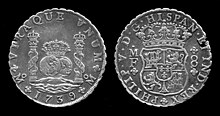
Back قاعدة الفضة Arabic Gümüş standartı Azerbaijani Estàndard argent Catalan Sølvfod Danish Silberstandard German Arĝentbazo Esperanto Patrón plata Spanish استاندارد نقره Persian Étalon-argent French 銀本位制 Japanese

The silver standard[a] is a monetary system in which the standard economic unit of account is a fixed weight of silver. Silver was far more widespread than gold as the monetary standard worldwide, from the Sumerians c. 3000 BC until 1873. Following the discovery in the 16th century of large deposits of silver at the Cerro Rico in Potosí, Bolivia, an international silver standard came into existence in conjunction with the Spanish pieces of eight. These silver dollar coins played the role of an international trading currency for nearly four hundred years.
The move away from the silver to the gold standard began in the 18th century when Great Britain set the gold guinea’s price in silver higher than international prices on the recommendation of Sir Isaac Newton, attracting gold and putting them on a de facto gold standard. Great Britain formalised the gold standard in 1821 and introduced it to its colonies afterwards. Imperial Germany’s move to the gold standard in 1873 triggered the same move to the rest of Europe and the world for the next 35 years, leaving only China (and, until 1930, the French Indochinese piastre) on the silver standard. By 1935 China and the rest of the world abandoned the silver and gold standards, respectively, in favour of government fiat currencies pegged to the pound sterling or the U.S. dollar.
Cite error: There are <ref group=lower-alpha> tags or {{efn}} templates on this page, but the references will not show without a {{reflist|group=lower-alpha}} template or {{notelist}} template (see the help page).
© MMXXIII Rich X Search. We shall prevail. All rights reserved. Rich X Search